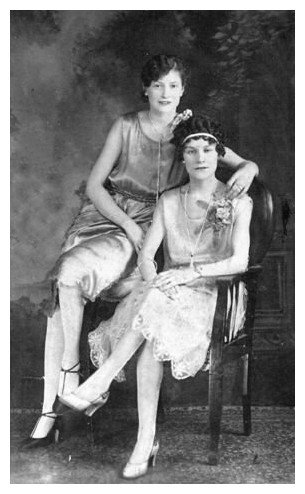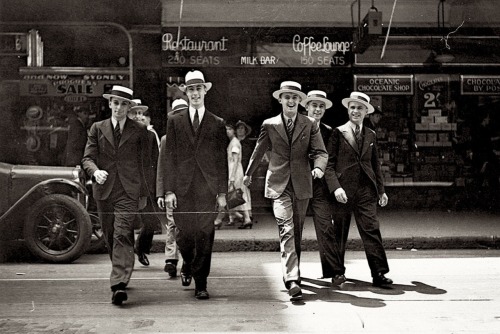The end of the War
The war created hardship and unhappiness, when it ended peoples social attitudes had changed and people began to look forward.
Fashion designers took peoples search for youthfulness and modernism into their designs. Dancing was also a major part of post war Britain, jazz bands held dances in large hotels and high society men spent the most of their time going to dances, waiting for jobs.
Attitudes
 The new attitudes of the 1920s altered peoples lifestyles, the younger generation were free to live away from their parents, clothes were more casual and manners were less formal.
The new attitudes of the 1920s altered peoples lifestyles, the younger generation were free to live away from their parents, clothes were more casual and manners were less formal.
Young girls went to events unaccompanied, they shortened their skirts, wore more make up and cut off their hair.
It was also more acceptable for young girls to smoke in public.
This was the birth of the flapper girl!

Young Men
 Men's fashion also became more casual, they drank cocktails and those who could afford it drove fast cars. Sports continued to become increasingly popular and sports clothing was suddenly a big fashion statement.
Men's fashion also became more casual, they drank cocktails and those who could afford it drove fast cars. Sports continued to become increasingly popular and sports clothing was suddenly a big fashion statement.
Hollywood
The women's new fashions and femininity was also publicised through cinema and young women strived to look like the movie stars. Theda Bara and Pola Negri both launched the fashion for eye make-up.
"Vamped"
During this decade eyes became the focal point, making them dark and intensely dramatic. It became fashionable to wear a ribbon, hat, band or thick fringe to cover the brow and forehead.
Bias Cut
Bias cut was the practise of cutting a pattern diagonal to the salvage edge, this created a flowing drape. This was primarily introduced by Madeleine Vionnet and was greatly influenced by the cubists.
Sleeves were long and full often with cuffs, low waistlines had loose blouses over them and scarves were often slung across the shoulder. Tassels and fringing were often hung from sleeves and hemlines.
Exhibition of decorative Arts
The exhibition of decorative arts was held in Paris in 1925, it was full of new contemporary, modern art and was full of art deco, buildings were rectangular and there were no curves in sight. Cubist art had replaced the smooth, bending lines of art nouveau.
Art deco focused on lines rather than decoration.

During this period architecture, art and fashion all weaved together creating a clear style for the decade.
Menswear
 Men began to wear a new popular style of trousers introduced by under graduates of oxford university. They were called "oxford bags" and were made from grey flannel, had a a long centre fold and got wider as they went down the leg.
Men began to wear a new popular style of trousers introduced by under graduates of oxford university. They were called "oxford bags" and were made from grey flannel, had a a long centre fold and got wider as they went down the leg. These were worn with casual blazers and skirts to create basic lounge suits.
Gigolos
This new male look was rivalled by "gigolos", these were dark young men usually with a south American background, they would wear finely pressed tail and suit trousers with their hair combed back.
Womenswear
This decade meant the decline of the tea dress and young girls opted for cocktails and the cocktail dress appeared in Paris fashion house collections and usually had beaded or embroidered detail.
Because of the demise of the corset, women's fashion was a more boyish figure and younger adolescent women's bodies became the wanted.
In 1925 Chanel designed straight hanging jersey dresses, which were sleek, elegant and expressed the jazz age.
This new style became available to everyone through mass market production, this took fashion into a classless world.
Moving Forward
 Towards the end of the decade women had a more social role and more revealing fashion was created. Tennis champion Suzanne Lenglen began the trend of having bare arms, when she wore a sleeveless sweater designed by Patou, this made a connection between sports and fashion for women.
Towards the end of the decade women had a more social role and more revealing fashion was created. Tennis champion Suzanne Lenglen began the trend of having bare arms, when she wore a sleeveless sweater designed by Patou, this made a connection between sports and fashion for women.The fashion industry developed this new exposed look, designing evening dresses with sleeveless bodices and cut away plunge backs.
The geometric lines of the early 1920's were replaced with curves and soft floral prints, femininity was making a come back.
Enjoying Life
The end of the century was about enjoying life after the harshness of the first world war. Leisure became a major part of society through cars, ocean liners and the birth of flying machines. The fashion industry was booming, couturiers, furriers, fabric printers and milliners created the age of opulence.
The Wall Street Crash
In 1929 the decade ended with the wall street crash, This depression created an ironic contrast to the richness, optimism and luxury of the roaring 1920's.
